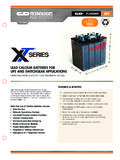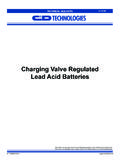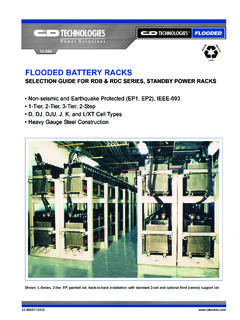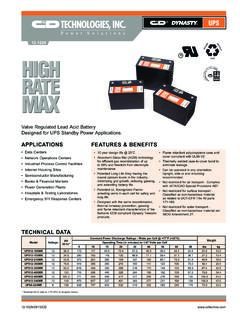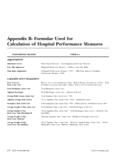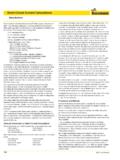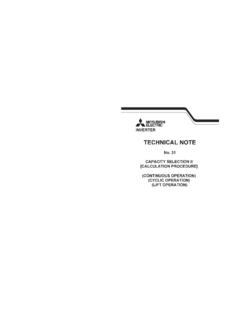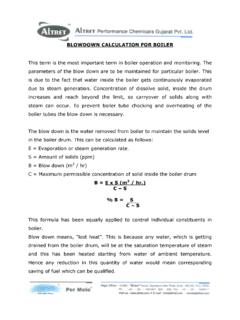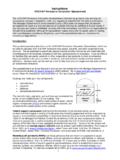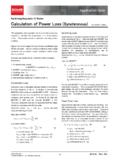Transcription of Capacity Testing of VRLA Batteries (20 to 200 …
1 Capacity Testing of vrla Batteries (20 to 200 Ampere-Hours Capacity )41-7135 TECHNICAL BULLETIN41-7135/0412/CD vrla battery is rated in ampere-hours or watts per cell (w/c) at specific discharge time durations. For example, a TEL series battery may be rated as a 100 Ah battery capable of amperes for 8 hours to v/c. A UPS series battery may be rated as capable of providing 475watts per cell for 15 minutes to Capacity test is simply a test designed to determine the actual capability of the battery as comparedto the rated capability.
2 If this Capacity test is performed at the factory prior to delivery or on site whenthe battery is first installed it is referred to as an acceptance test. If the test is performed with the battery in an as found condition with no special preparation, it is referred to as a service test. When acapacity test is being performed to determine the battery s percent of rated Capacity for service lifedetermination or warranty purposes, it is referred to as a performance test and is conducted exactlyas is the acceptance PREPARATIoN foR ACCEPTANCE TEsTINgThe battery system should be assembled at the manufacturer s site, simulating the user s installation,or completely installed at the user s location following relevant installation instructions (ref form 41-6965).
3 And record all cells/units open circuit voltage to assure minimum acceptable voltage prior to interconnecting (Ref to Table 2, col. 12). individual cells/units should be interconnected using the intercell/unit cables or busbars specified for the application and with which the battery s performance is rated. It is important that all cell/unit terminals and contact surfaces of the intercell/unit connecting cablesand bus bars be properly cleaned and greased prior to installation and the bolted connections beproperly torqued per Table 1, column 4. Improper connections can result in low measured Capacity due to voltage drop at the the battery for 24 hours at the recommended voltage ( , volts/cell) to assure the battery is fully charged (refer to Table 2, column 10).
4 Equalization, the battery should be placed on float charge at the recommendedvoltage ( volts/cell) for 3 to 7 days prior to acceptance prior to initiating the acceptance Capacity test, measure and record the individual cell/unit float TEsT TImE ANd dIsCHARgE RATE discharge time and end point voltage selected should be one at which the batteryhas a published rating and is approximately the same as that of the intended discharge rate (amperes or watts/cell) to a specified end point voltage for the selected time, as taken from the published ratings for the battery must be adjusted forbattery temperature if outside the range of 75 F to 80 F.
5 For elevated temperature, the rate will be increased; while for cooler temperatures, the rate is reduced. The temperature adjustment factors are rate dependent and are noted in Figure 2 3 example, if a cell having a one hour rating of amperes to V/cell @ 77 F were tested at60 F.
6 The discharge rate used for a 1 hour discharge would be: amperes x = ampereFor accuracy, Capacity tests should only be performed between 60 F and 90 F, and as close to 77 Fas Capacity TEsT PRoCEdUREs1. Equipment requirementsa. Load bank capable of providing the appropriate discharge current and kilowatt Digital voltmeters to monitor full battery discharge Amp meter to monitor battery discharge Digital voltmeter to monitor individual cell/unit voltages during the Stop watch to monitor time of the Performancea. Assure that the instrumentation is operational and properly connected to the batteryto continuously monitor battery discharge voltage and current (Figure 2 or 3).
7 If parallelstrings are being tested, the individual string current and total current must both be Measure and record the float voltage of each cell/unit and ensure all cells/units are floating Remove the charging current from the With the Load Bank OFF, connect it to the Start the timer and turn the Load Bank ON, adjusting and maintaining it for the appropriate discharge rate (amperes or watts).f. Record the battery discharge voltage and current with battery terminals and time atthe start and end of the test and periodically throughout the test as many times individual cell/unit voltages shall also be measured and recorded as often as is practical during the discharge.
8 The number of sets of discharge readings must be 3 ormore. The longer the test duration, the more readings should be taken so the capacityof individual cells can be the discharge beyond the required battery end point voltage ( , V/C) to a lower rated voltage ( ) when possible to assure most cells actually discharge to the required end the Capacity test when the battery is discharged to the predetermined system end point voltage, a cell or unit is going into reversal, or a safety hazard is noted. CALCULATINg BATTERy CAPACITyThe ampere-hour rating is the product of the number of amperes of current the battery can supplymultiplied by the number of hours (or fraction thereof) over which the current is supplied to a specifiedend point voltage.
9 For example, a TEL12-125 series is rated as a Ah battery at the 8 hour discharge rate of amperes ( Amperes x 8 hours = Ah) to v/c when new and at100% of rating. It is also rated capable of providing amperes for 5 hours (117 Ah) and amperes for 4 hours ( Ah) to v/c. Notice that as the load current increases, the battery becomes less percent of rated Capacity would be the ratio of the Ah provided at a given discharge rate for theactual operating time to the rated Ah Capacity for the same period and operating conditions. For example, if the TEL12-105 were discharged at the 5 hour rate of amperes and it reached the endpoint voltage of v/c at the 4 hour mark, the resulting Ah delivered would be ( amperes x4 hours = Ah).
10 Since the 4 hour rated Capacity is Ah the percent rated Capacity at the 4hour discharge rate is (100% x Ah) rather than 80% as would be deduced fromthe ration of the operating time to the rating time (100% x 4 hours/5 hours).Since the ratios of Ah s are both at the same time duration, the percentage rated Capacity can also beconsidered the ratio of the actual load current for the actual test duration to the rated ampere load forthat same actual test is a very important concept in that the greater the discharge rate, the greater will be the difference between the ratio of Ah s (or currents) obtained verses the operating times.
